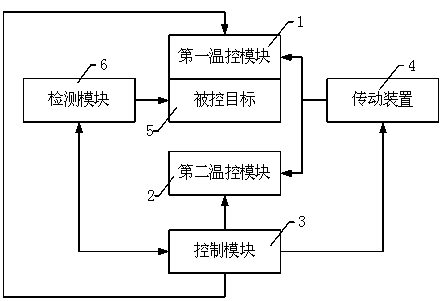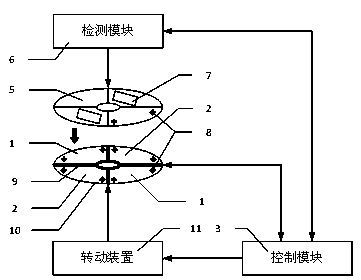Device and method applied in gradient temperature control
A gradient temperature and constant temperature control technology, which is applied in the direction of temperature control using electric methods, biochemical equipment and methods, biochemical cleaning devices, etc., can solve problems such as overshooting, shortening service life, and affecting the rate of heating and cooling of sample modules. , to achieve the effects of flexible temperature control, extended service life, and scalability
- Summary
- Abstract
- Description
- Claims
- Application Information
AI Technical Summary
Problems solved by technology
Method used
Image
Examples
Embodiment 1
[0027] see Figure 1-4 , a translation device suitable for gradient PCR reactions based on the principle of time-division multiplexing of temperature control modules, consisting of a first temperature control module 1, a second temperature control module 2, a control module 3, a transmission device 4, and a controlled target 5 Composed of a detection module 6, the first temperature control module 1 and the second temperature control module 2 are connected to the transmission device 4, and the transmission device 4 controls different temperature control modules to move or rotate and physically contact the controlled target 5. The control module 3 and the The transmission device 4 is connected, and the control module 3 outputs control signals to control the transmission device 4 to generate corresponding actions. The signal controls the temperature control module to realize temperature changes. The detection module 6 is connected to the controlled target 5. The detection module ...
Embodiment 2
[0033] see figure 1 and figure 2 , is a schematic structural view of two PCR thermal cyclers based on the present invention, because the transmission device 4 in the two examples realizes the controlled target 5 and the temperature control module (the first temperature control module 1, the second temperature control module 2 ) linear motion in physical contact, so they are explained together. The difference between the two is that Figure 13A uses a translational transmission, figure 2 Use the longitudinal transmission device, which can be selected according to actual needs. The two PCR thermal cyclers mainly include a control module 3 , a first temperature control module 1 , a second temperature control module 2 , a transmission device 4 , a controlled target 5 and a detection module 6 .
[0034] The temperature control modules (the first temperature control module 1 and the second temperature control module 2 ) include a heating module, a cooling module, a heat dissipat...
Embodiment 3
[0044] see image 3 , Figure 4 , is a structural schematic diagram of a disc-type PCR thermal cycler based on the present invention, the corresponding device uses a rotating device 11 to realize rotational positioning, and realizes the controlled target 5 and the temperature control module (the first temperature control module 1, the second temperature control module physical contact with the control module 2). It should be noted that the shapes of the controlled target 5 and the temperature control module suitable for the rotating device 11 are not limited to the shape of a disc, but can also be fan-shaped, diamond-shaped, square, polygonal, and irregular polygonal, etc. Figure 4 It is a top view structure schematic diagram of a supporting sample loading disc. Figure 7 (Patent: CN 102277294B figure 2 ) is a schematic diagram of an integrated flow chip suitable for performing digital PCR reactions in the device of the present invention. The integrated flow path chip m...
PUM
 Login to View More
Login to View More Abstract
Description
Claims
Application Information
 Login to View More
Login to View More - R&D
- Intellectual Property
- Life Sciences
- Materials
- Tech Scout
- Unparalleled Data Quality
- Higher Quality Content
- 60% Fewer Hallucinations
Browse by: Latest US Patents, China's latest patents, Technical Efficacy Thesaurus, Application Domain, Technology Topic, Popular Technical Reports.
© 2025 PatSnap. All rights reserved.Legal|Privacy policy|Modern Slavery Act Transparency Statement|Sitemap|About US| Contact US: help@patsnap.com



